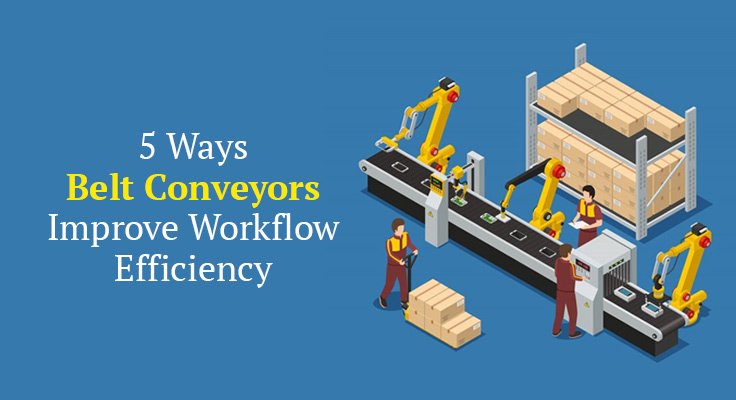As you may already know, industrial conveyor systems transport products or objects from one location to another using belts, rollers, or chains. However, these material-handling equipment hold significant value in various other industries, transporting an array of materials in large numbers swiftly and economically and may be installed in practically any place.
The features of the objects being conveyed, the intended system speed, the space provided, and the types of existing machinery on each end are all considered when deciding the sort of conveyor necessary for a project.
Besides, the physical conveying material chosen for a system is also determined by the products being conveyed and environmental factors.
For instance, food sector conveyors must be composed of food-safe materials that meet sanitary standards. In contrast, bulky products or larger manufactured materials may necessitate a heavy-duty powered roller conveyor.
Conveyor systems regularly carry a wide variety of items, including:
- Cartons
- Containers include totes, cans, bottles, drums, pallets, and parcels
- Food products
- Parts and components
- Shipping containers
- Unpackaged products
Types of Conveyor Systems
There are several types of conveyor systems, each with its own set of applications and material handling requirements. That said, belt conveyor is versatile and ideal for transporting items over long distances;
Roller conveyors, on the other hand, are used for heavier loads, typically in assembly lines or warehouses; screw conveyors are used to transfer granular or powdered products; and chain conveyors provide reliable transportation for bulky or heavy objects. Other types include vibrating conveyors, widely used for delicate or unusually shaped products, and overhead conveyors, which transport objects suspended from a track to maximize floor space in congested places. Each variety has various advantages, depending on the task’s requirements.
There are several conveyor orientations and permutations. The straight horizontal conveyor is the most basic and well-known type; however, there are other variations. For example, a vertical conveyor can transport goods from one level to another, whereas circular conveyor belts are commonly used to transport cargo through airports.
Additionally, in warehousing and distribution, roller conveyors make it easier to transport packages or components. Ultimately, conveyor systems of all varieties save money by moving things swiftly, efficiently, and, most importantly, safely.
The following are a few major advantages of employing belt conveyors to improve work efficiency.
1. Automated transportation of goods
Conveyor belt systems automate the transportation of parts and goods, increasing throughput significantly, for they tend to minimize the time, cost, and labor required for manual procedures, resulting in increased packing output even in organizations with a smaller workforce. As a result, higher productivity and more efficient procedures lead to higher returns.
2. Reduced energy consumption
Belt Conveyor systems make packing processes more energy-efficient by automating product movement. Many systems can also be configured in such a way that certain components run at a specific time, hence minimizing energy use.
Along with lowering your carbon footprint, this has a significant impact on the cost of everyday operations and the return on investment (ROI) for your company.
3. Lower likelihood of accidents
Workplace safety is a critical component of every successful organization, yet manual movement of parts and products has a high risk of damage. Conveyor belts mitigate much of this danger for your employees by decreasing exposure to machinery, heavy loads, and other hazards. Increased automation also reduces workloads, making staff happy and productive.
4. Increased accuracy and reliability
Conveyor systems not only improve the speed and safety of product transportation, but they also provide a high level of precision throughout the packing process. Conveyor scales, for example, can be integrated with existing warehouse management systems to facilitate data gathering and analysis, as well as sorting, weighing, and tracking at all stages of operations.
5. Maximizing Floor Space
Floor space is sometimes in short supply in packaging, warehouse, and distribution facilities. This is not an issue with conveyor systems, which may make the most of available roof space and be tailored to each business region. These systems offer more floor area for other operations by utilizing overhead space and routing components around impediments.
With correct planning, the appropriate conveyor system and accompanying components may ensure that packaging activities are completed faster and more accurately. If you invest in a clever system that can be readily modified to different container sizes, you will have more flexibility.
Conveyor Belt Installation Service: Beyond Assembly
The Conveyor Belt Installation Service involves more than just constructing equipment; it also ensures efficient and safe implementation. This also gives way to how qualified personnel can tailor the installation to extend the life of conveyor belts and improve their performance.
Furthermore, perform preventative maintenance on a regular basis to guarantee your supply chain runs smoothly and without costly delays. In addition, by implementing modern monitoring systems during installation, you may acquire real-time data on conveyor belt performance, allowing for more informed supply chain management decisions.
In the end!
Belt conveyors greatly improve workflow efficiency by speeding up material handling, lowering labor expenses, and increasing safety. By automating the transportation of commodities, they reduce delays and ensure constant output. Their ability to integrate with different production systems increases operational flexibility and scalability.
In addition, the ergonomic design of belt conveyors reduces strain on workers, increasing productivity and decreasing injuries. Overall, these systems provide a dependable, cost-effective option for organizations looking to improve their supply chain and production processes, resulting in smoother, faster, and more efficient operations.
Also Read: Best Practices for Managing Remote Teams Across Different Time Zones






















